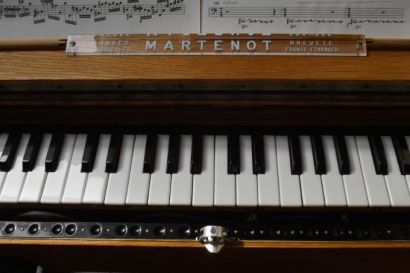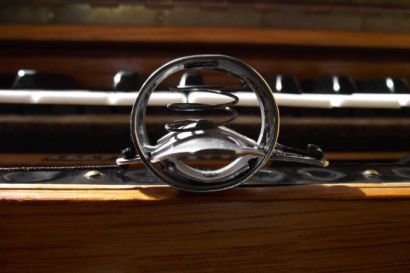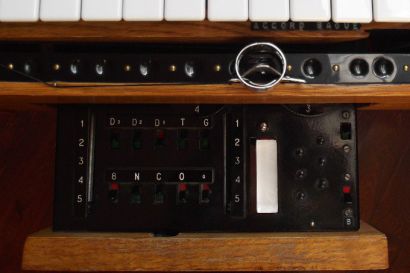For composers
The Ondes is an electronic monodic instrument invented in 1928 by Maurice Martenot (1898-1980). Its seven-octave range divides in 2 positions: bass and treble. Each position provides access to six octaves. A lever must be activated in front of the keyboard to switch from one position to the other.


Notation can be done on a single stave with clef changes if required (using bass and treble clefs), or on two staves, when needed.
It features two performing techniques: playing on the keyboard and playing with the ring (or ribbon: à la bague ou au ruban). Overall, the right hand generates pitches, either with the keyboard or with the ring. The left hand, for its part, controls dynamics, attacks and articulations with the dynamics control key (touche d’intensité).

The keyboard makes it possible to play in a virtuoso style. The right hand plays on the keyboard while the left hand modulates the dynamics control key; or both hands combined with the pedal. Since the keyboard is mobile, allowing lateral movement, it can produce expressive vibrato.
One chooses to play either with the keyboard or the ring with a switch that allows to change from one mode to the other, using a single mode of playing at a time. It’s possible to switch rapidly from keyboard to ring (and vice-versa) by keeping the ring on the finger while playing with the keyboard. However, this can sometimes prove unpractical when performing difficult passages on the keyboard, so each section or even movement should preferably be written for either one mode or the other.

The ribbon or ring is played with the right hand, this most often in combination with the dynamics control key, for greater refinement in nuances, while being rarely used in combination with the pedal. It allows for continuous glissandi movement through all six octaves (in either bass or treble positions). One could well compare its expressive potential to that of a voice or a string instrument. The vibrato is controlled laterally, much like it is on the keyboard. It is best suited for slow and expressive lines, as well as various special sound effects. It can produce every imaginable intonation and inflexion.

The dynamics control key (touche d’intensité) makes it possible to produce a wide spectrum of dynamics, ranging from the subtlest pianissimo to powerful fortissimo, much like a violin bow or the breath of a flute player. All traditional types of articulations are possible: legato, détaché, staccato, accents and percussive/staccato. Legato can be played very fast, ± = 160. Détaché can easily be played up to ± = 104. Staccato is limited to ± = 116. One can also play a key tremolo with fast repeated notes at ± = 132. Fast repeated notes on the keyboard with key release (claquements) are possible at ± = 160. Percussive notes are notated with a small circle over the note . Dynamics are partly determined by selected timbres and speakers (diffuseurs). For instance, a “pure” timbre will be limited to p nuances, whereas the more it is “gamba-like”, its dynamics spectrum will expand to fortes.
The dynamics pedal is used in place of the dynamics control key, mostly when both hands are used on the keyboard or to allow a page turn, for instance, although it proves less versatile than the control key. One uses the pedal for legato or simple détaché passages. A second pedal, called the timbre pedal, complements the dynamics control key and pedal. It serves as a progressive harmonics filter, a sort of damper that makes it possible to move progressively from one timbre to another, or obtain a dynamic that verges on silence (this replaces what used to be called genouillère.
Timbres O, C, g, G, N, T, 8 and S designate simple sine wave forms that can be used individually or in combination. They build from a simple sine wave O = wave to which one adds various harmonics. C = creux (“hollow”), g = petit gambé (“small gamba”, which can be modulated from 1 to 5 with a slider), G = grand gambe (“large gamba”), N = nasillard, T = tutti, 8 = octaviant (this adds the first harmonic of an octave, to be combined to another timbre), S = souffle or white noise. F for “feutré” (“felt-like”), a filter which softens certain timbres. A timbre (or group of timbres) will take on a different color depending on the chosen speakers (“diffuseurs”).
The Ondes feature one speaker and three resonators: D1: normal membrane loudspeaker, dry and powerful; D2: spring resonance; D3: the “gong” resonance of a tam tam; D4 “palm”: string resonance. The resonators are fragile and seldom used nowadays, D3 and D4 having been efficiently replaced by digital multiprocessors.
The transposing buttons make it possible, in combination with the keyboard, to produce quarter-tones (also 1⁄3, 1⁄6, 1⁄8 and 1⁄12th tones) as well as an aiguilles effect (rapid random multi-sounds tremolo). Microtonality is thus possible using either the keyboard or the ribbon.
Trills and tremolos prove to be very effective and easy to perform. Tremolos sound more homogenous when played with resonance speakers.
When performed with the ribbon, legatos and glissandos can either be notated with great precision or simply approximated, or can even be left to the performer’s skill and imagination.
Notation is mostly traditional, at times graphic and sometimes mixing both techniques. As examples, one may study scores by Messiæn, Jolivet and Murail. A score’s final indications regarding playing mode, use of speaker and resonators, choice of timbres, etc., are best done in conjunction with the performer and can slightly vary depending on the instrument used.
Suggested Listenings
-
Turangalîla Symphonie
by Olivier Messian for piano, Ondes and orchestra
-
Trois petites liturgies de la Présence Divine
by Olivier Messiaen for female voices, Ondes and ensemble
-
Saint-François d’Assise
opera by Olivier Messiaen (3 Ondes in the orchestra)
-
Concerto pour ondes et orchestre
by André Jolivet
-
Uaxuctum
by Giacinto Scelci for orchestra (including 1 Martenot)
-
Mach 2,5
by Tristan Murail for 2 to 6 Ondes
-
La Conquête de l’Antarctique
by Tristan Murail for Ondes solo
-
Ecuatorial
by Edgard Varèse for bass voice, 2 Ondes and ensemble
-
Voix blanche
by Gilles Gobeil for Ondes and tape
-
La Contemplation de l’eau par le feu
by Richard Boucher for Ondes solo and 2 supporting Ondes
